What Is Biomimicry?
Biomimicry takes the best features of the flora and fauna around us and turns it into products and technologies that can make our lives better. Elements that help animals and plants prosper can be harnessed to make buildings perform more efficiently and machines work more effectively.
Humans have thought about copying the natural world for centuries. Using feathers glued to his arms with wax, the young Icarus of Greek mythology aimed to fly like a bird in a bid to escape a cave high in a cliff above the sea, where he had been imprisoned along with his inventor father, Daedalus.
Sadly, the boy came to a sticky end. He ignored his father’s pleas to not fly too close to the sun, the wax holding the feathers to his arms melted, the feathers blew away and Icarus plunged to his doom.
The story of Icarus is just a legend, but it demonstrates an early attempt to use the natural world as a model for human achievement. Later, in the 16th century, Leonardo da Vinci designed a flying machine that clearly mimicked a bird, although the power-to-weight ratio required meant the pilot would have struggled to get the machine off the ground.Fast forward more than 500 years and engineers are still looking to the natural world as a source of inspiration, but with considerably greater impact.
Modern Examples of Biomimicry
While da Vinci was ahead of his time, nowadays there are more examples of biomimicry engineering than you can shake a stick at. Or a flipper.
Take the aptly-named Frank Fish. The U.S. professor of biology discovered that the bumps—called tubercles—situated on the leading edge of a humpback whale’s flipper helped the animal turn in tight circles when it hunted for food. In effect they act as an aerodynamic booster.
Subsequent tests using modifications of the whale’s “technology” on wind turbine blades, fans and ship’s rudders have made them more aerodynamic. Some have even suggested that manufacturing an aircraft’s wings with such nodules could improve flight safety and fuel costs by the removal of control surfaces needed to change their stall characteristics.
Biomimicry In Architecture: The Gherkin
There are plenty of other examples of biomimicry in architecture. One example in construction is the biomimicry of the “Gherkin” building in the city of London, otherwise known as 30 St Mary Axe.
The Gherkin wasn’t inspired by the green vegetable, despite its shape. Instead, its external lattice-like structure mimics that of the Venus’s flower basket sea sponge and encourages air to flow around the outside of the building, which architect Norman Foster used to help power a natural ventilation system, along with large air intakes at ground floor level, reducing the need for air conditioning by a whopping 50%.
Meanwhile in Zimbabwe, another structure was designed mindful of what our fellow creatures can get up to when they’re out of sight. The Eastgate shopping centre was designed using ventilation technology inspired by the giant mounds built by termites.
The mounds—often several metres tall—act as ventilation devices for the termites living below them, and use a unique air flow system that appealed to efficiency-conscious designers.
Mick Pearce, the Eastgate shopping centre’s architect, designed the building to be ventilated and cooled by natural means, avoiding the high costs that come with controlling temperatures in a glass office block.
Mycelium Marvel, Plastic Perfection
Vegetables get in on the act, too. London-based Biohm has developed an insulation panel for buildings which uses mycelium, the vegetative filament root structure of mushrooms.
The firm claims insulation panels made with mycelium have better thermal and fire performance than their non-mycelium rivals and are more sustainable, thanks to mycelium’s penchant for consuming organic and synthetic waste, which would otherwise go to landfill.
Elsewhere, researchers at the University of Cambridge have developed a plastic-like film derived from soy proteins that mimics the properties of spider silk, one of the strongest materials in nature.
The university said researchers had successfully repeated the structures found in spider silk by using soy protein isolate. “Because all proteins are made of polypeptide chains, under the right conditions we can cause plant proteins to self-assemble just like spider silk,” said Professor Tuomas Knowles in Cambridge’s Yusuf Hamied Department of Chemistry.
The construction industry—and engineering projects in general—should perhaps be making greater use of biomimicry design, but there seems to be a reluctance on the part of the investment community to get involved.
Biomimicry Innovation vs Investor Inertia?
Michael Pawlyn, founder of London-based biomimetic architecture firm Exploration Architecture, told the Institute of Mechanical Engineering that part of the problem with biomimicry in architecture surrounded the logistics—and cost—involved in researching and developing potential outcomes.
“Biomimicry innovation has certain advantages over other approaches, the main one being that biomimicry is based on ideas that have been proven to work in nature. But a lot of the ideas that emerge require proper R&D, and that can be difficult within the constraints of a conventional project,” he said.
“The other major obstacle is that often we are able to propose solutions that are much better in the longer term—environmentally, economically and socially—but they are slightly more expensive in the short term.”
Such reluctance will surely wane as various efforts to drive efficiency and sustainability throughout society—and sustainability in the built environment in particular—gather momentum in the face of calls to combat the impact of climate change.












